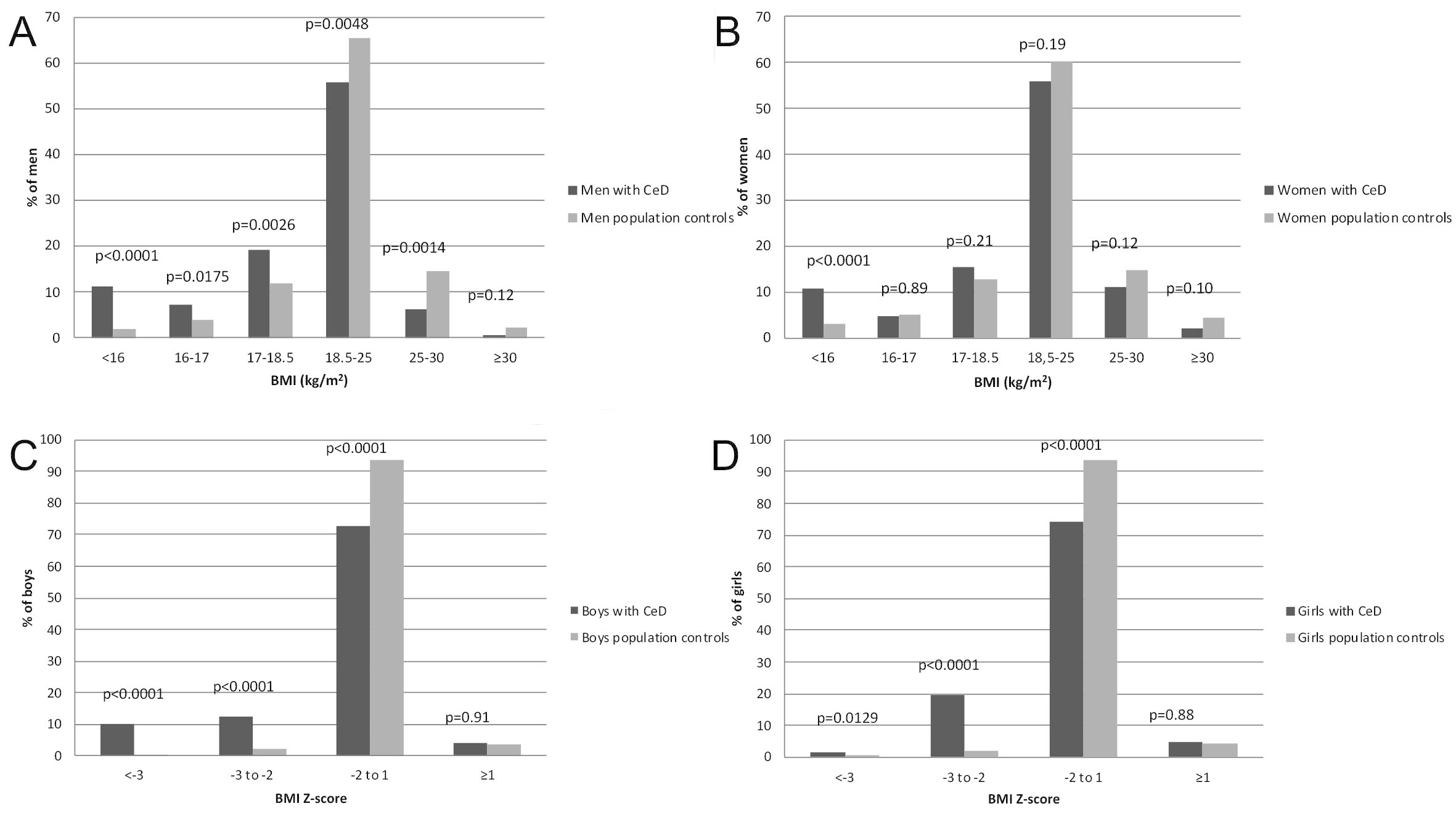Back
Poster Session B - Monday Morning
B0633 - Spectrum of Body Mass Index in Patients With Celiac Disease
Monday, October 24, 2022
10:00 AM – 12:00 PM ET
Location: Crown Ballroom

Nishant Aggarwal, MBBS
Beaumont Health
Royal Oak, MI
Presenting Author(s)
Nishant Aggarwal, MBBS1, Vignesh Dwarakanathan, MBBS, MD2, Ashish Agarwal, MBBS, MD, DM3, Alka Singh, PhD2, Sana Dang, MBBS4, Vineet Ahuja, MBBS, MD, DM2, Govind Makharia, MBBS, MD, DM2
1Beaumont Health, Royal Oak, MI; 2All India Institute of Medical Sciences, New Delhi, Delhi, India; 3All India Institute of Medical Sciences, Jodhpur, Rajasthan, India; 4Vardhaman Mahavir Medical College & Safdarjung Hospital, New Delhi, Delhi, India
Introduction: Although generally perceived to be mostly underweight, patients with celiac disease (CeD) can be of normal weight or even overweight/obese. We conducted a comparative cross-sectional study to assess the body mass index (BMI) of treatment-naïve patients with CeD in comparison to the population controls.
Methods: In a retrospective analysis of a prospectively maintained database of treatment-naive patients with CeD, we included 583 patients (419 adults [43.7% males] and 164 adolescents [43.9% males]). Details extracted from our database included demographic details, height, weight, laboratory and histopathological parameters. The data of 375,460 adults (12.7% males) and 71,315 adolescents (12.1% males) of Indian National Family Health Survey-4 was considered as the population controls.
Results: Although majority of adult and adolescent patients with CeD patients had BMI in normal or underweight range, a significant proportion were overweight or obese (adults 10.3%, adolescents 3.7%). The mean BMI in patients with CeD was significantly lower than the population controls for adults (men 19.8 vs 21.8 kg/m2, p < 0.001; women 20.5 vs 21.8 kg/m2, p < 0.001) and adolescents (BMI Z-scores: boys -1.4 vs -0.5, p < 0.001; girls -1 vs -0.4, p < 0.001). Higher proportion of adults (men 11.2% vs 1.9%, p < 0.001; women 10.7% vs 3.2%, p < 0.001) and adolescents (boys 10.4% vs 0.2%, p < 0.001; girls 1.6% vs 0.2%, p = 0.01) with CeD were severely underweight compared to population controls
Discussion: While majority of adult and adolescent patients with CeD have a lower BMI compared to population controls, a significant proportion can be overweight and even obese.

Disclosures:
Nishant Aggarwal, MBBS1, Vignesh Dwarakanathan, MBBS, MD2, Ashish Agarwal, MBBS, MD, DM3, Alka Singh, PhD2, Sana Dang, MBBS4, Vineet Ahuja, MBBS, MD, DM2, Govind Makharia, MBBS, MD, DM2. B0633 - Spectrum of Body Mass Index in Patients With Celiac Disease, ACG 2022 Annual Scientific Meeting Abstracts. Charlotte, NC: American College of Gastroenterology.
1Beaumont Health, Royal Oak, MI; 2All India Institute of Medical Sciences, New Delhi, Delhi, India; 3All India Institute of Medical Sciences, Jodhpur, Rajasthan, India; 4Vardhaman Mahavir Medical College & Safdarjung Hospital, New Delhi, Delhi, India
Introduction: Although generally perceived to be mostly underweight, patients with celiac disease (CeD) can be of normal weight or even overweight/obese. We conducted a comparative cross-sectional study to assess the body mass index (BMI) of treatment-naïve patients with CeD in comparison to the population controls.
Methods: In a retrospective analysis of a prospectively maintained database of treatment-naive patients with CeD, we included 583 patients (419 adults [43.7% males] and 164 adolescents [43.9% males]). Details extracted from our database included demographic details, height, weight, laboratory and histopathological parameters. The data of 375,460 adults (12.7% males) and 71,315 adolescents (12.1% males) of Indian National Family Health Survey-4 was considered as the population controls.
Results: Although majority of adult and adolescent patients with CeD patients had BMI in normal or underweight range, a significant proportion were overweight or obese (adults 10.3%, adolescents 3.7%). The mean BMI in patients with CeD was significantly lower than the population controls for adults (men 19.8 vs 21.8 kg/m2, p < 0.001; women 20.5 vs 21.8 kg/m2, p < 0.001) and adolescents (BMI Z-scores: boys -1.4 vs -0.5, p < 0.001; girls -1 vs -0.4, p < 0.001). Higher proportion of adults (men 11.2% vs 1.9%, p < 0.001; women 10.7% vs 3.2%, p < 0.001) and adolescents (boys 10.4% vs 0.2%, p < 0.001; girls 1.6% vs 0.2%, p = 0.01) with CeD were severely underweight compared to population controls
Discussion: While majority of adult and adolescent patients with CeD have a lower BMI compared to population controls, a significant proportion can be overweight and even obese.

Figure: Figure: Graphs depicting comparison of adult and adolescent patients with celiac disease (CeD) against population controls from India. (A) Spectrum of body mass index (BMI) in men with CeD as compared to population controls. (B) Spectrum of BMI in women with CeD as compared to population controls. (C) Spectrum of BMI in boys with CeD as compared to population controls. (D) Spectrum of BMI in girls with CeD as compared to population controls.
Disclosures:
Nishant Aggarwal indicated no relevant financial relationships.
Vignesh Dwarakanathan indicated no relevant financial relationships.
Ashish Agarwal indicated no relevant financial relationships.
Alka Singh indicated no relevant financial relationships.
Sana Dang indicated no relevant financial relationships.
Vineet Ahuja indicated no relevant financial relationships.
Govind Makharia indicated no relevant financial relationships.
Nishant Aggarwal, MBBS1, Vignesh Dwarakanathan, MBBS, MD2, Ashish Agarwal, MBBS, MD, DM3, Alka Singh, PhD2, Sana Dang, MBBS4, Vineet Ahuja, MBBS, MD, DM2, Govind Makharia, MBBS, MD, DM2. B0633 - Spectrum of Body Mass Index in Patients With Celiac Disease, ACG 2022 Annual Scientific Meeting Abstracts. Charlotte, NC: American College of Gastroenterology.
